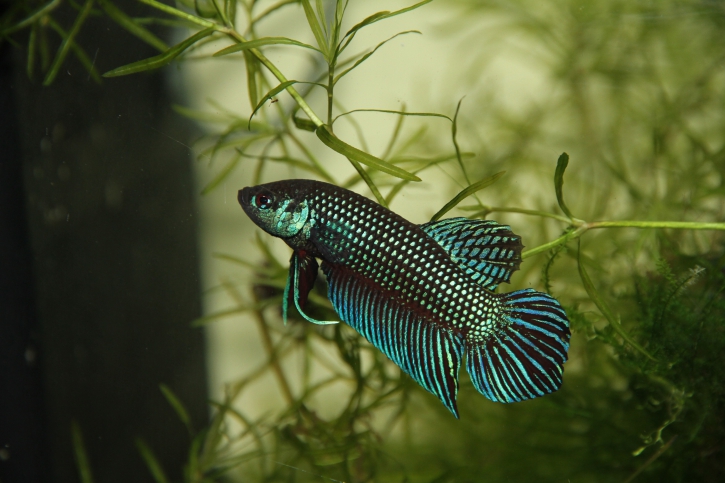Betta mahachaiensis – Full Caresheet

Betta fish, with their flowing fins and vibrant colors, are a staple of the aquarium hobby. But did you know there’s a whole world of wild Betta species out there? One such species, the Betta mahachaiensis, is a fascinating and increasingly rare jewel that deserves our attention.
Betta mahachaiensis
Betta mahachaiensis is a wild betta species native to Thailand, specifically found in coastal brackish water habitats, including mangrove swamps and lowland ponds. It is part of the Betta splendens complex but stands out due to its ability to tolerate slightly brackish water—a rare trait among bettas.
Physical Characteristics
- Size: Grows to around 5–6 cm (2–2.5 inches) in length.
- Coloration: Displays iridescent blue-green scales with a blackish body. Males exhibit more vibrant metallic colors, especially when displaying or breeding.
- Finnage: Shorter and more compact than domesticated bettas, with males having slightly elongated dorsal and anal fins.
- Sexual Dimorphism: Females are duller in color and have shorter fins compared to males.
Quick Betta Mahachaiensis Facts
Click here for my favorite betta fish care guide that simplifies betta ownership…
| Common Name | Betta mahachaiensis |
| Origin | Central Thailand (Samut Sakhon province) |
| Habitat | Brackish water environments with Nipa palm trees |
| Conservation Status | Endangered due to habitat destruction and the aquarium trade |
| Appearance | Iridescent green-blue scales with a black background |
| Temperament | Peaceful but males can be territorial |
| Tank Size | Minimum 5 gallons for a single male, 15-20 gallons for pairs |
| Water Conditions | Temperature: 72°-80°F, pH: 6-7.5 |
| Diet | Carnivorous (prefers live or frozen foods such as mosquito larvae, daphnia, bloodworms) |
| Breeding | Requires conditioned pairs and a well-prepared environment; males build bubble nests for spawning |
| Lifespan | 1-2 years or up to 5-7 years with proper care |
Wild Origins and Unique Beauty
Hailing from the wetlands of central Thailand, Betta mahachaiensis was only recently discovered and scientifically classified in 2012. They inhabit a specialized environment of brackish waters, often surrounded by Nipa palm trees. Unlike the flamboyant domesticated Betta splendens, these fish display a more subtle beauty. Their scales shimmer with iridescent greens and blues against a dark background, while their fins are shorter and less extravagant. Females are usually less colorful than males, a distinction important to know for anyone considering breeding.
A Species in Peril
Sadly, Betta mahachaiensis is facing serious threats. Habitat destruction, pollution, and over-collection for the aquarium trade are pushing them towards extinction. This is why responsible choices as aquarists are more critical than ever. If possible, seek captive-bred Betta mahachaiensis to help reduce pressure on wild populations.
Creating a Haven for Your Betta Mahachaiensis
Betta Fish Need The Right Care To Be Happy! Click Here For What You Need to Know…
Interested in bringing one of these unique fish home? Here’s what you need to create a thriving environment:
- Tank Setup: Start with a minimum tank size of 5 gallons for a single Betta, though larger is always better. Focus on a densely planted paradise with options like java fern, mosses, and anubias. Leaf litter (like Indian almond leaves) will add natural tannins and create a shaded, calming environment.
- Water Conditions: Aim for a temperature between 72°-80°F and a pH of 6-7.5. Most tap water, after proper conditioning, should be suitable. While these Bettas can tolerate some brackish conditions, there’s no need to add salt unless specifically recommended for health reasons.
- Feeding: In nature, they feast on insects and small invertebrates. Replicate this with live or frozen foods like bloodworms, mosquito larvae, and daphnia. Some individuals can be trained onto high-quality pellets or flakes.
- Tankmates: Betta mahachaiensis are generally peaceful, though males can still get territorial. Single-species tanks are safest, but with ample space and hiding places, you might try peaceful nano fish or specific invertebrates like Amano shrimp. Just be prepared to separate them if problems arise.
The Joy of Breeding
If you’re up for the challenge, breeding Betta mahachaiensis can be incredibly rewarding. Provide a well-conditioned pair with plenty of live foods, and watch as the male creates a mesmerizing bubble nest. Be diligent about water changes and feeding tiny fry to ensure their survival.
A Call for Responsible Care
Betta mahachaiensis can live for several years with proper care. By understanding their unique needs, we can enjoy this captivating species and contribute to its conservation. Let’s spread awareness and make ethical choices to ensure these stunning wild Bettas swim in our aquariums and their natural habitats for generations.


